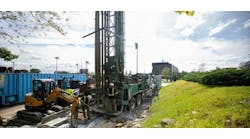As the Environmental Protection Agency has stepped up its enforcement, colleges and universities have come under greater regulatory scrutiny. Many educational institutions could benefit from environmental-management programs to address complex ecological issues.
Schools that improve their environmental management can meet EPA requirements more easily and demonstrate a commitment to being responsible members of their communities. Environmental improvement also brings economic benefits, including reduced waste-disposal costs — a significant expense for many colleges and universities.
Campus issues
The decentralized structure of higher education (separate academic and administrative hierarchies) can be an obstacle to improving environmental conditions, as the roles, responsibilities and authorities for environmental management often may be unclear.
From an environmental perspective, colleges and universities encompass many diverse activities. Some operate power and wastewater treatment plants, provide drinking water, trash disposal and recycling, and maintain buildings, grounds and recreational facilities. Perhaps the greatest environmental challenges at these institutions are laboratories, including medical centers, because of the special materials used and the risks associated with these facilities.
The environmental, health and safety burdens placed on campuses to support these activities are enormous. Regulatory requirements are complex, and researchers accustomed to working autonomously are not used to the restrictions the requirements impose. Even large universities with sophisticated environmental-management systems (EMS) and resources have difficulty responding to changing campus needs and ensuring environmental compliance. Smaller colleges face an even greater challenge, because they must respond to the same environmental requirements with a much smaller organization and budget.
Schools should have a cost-effective strategy for responding to environmental issues. The EPA's recent efforts, directed at improving the compliance of colleges and universities, include both assistance and aggressive enforcement. Many unannounced inspections have resulted in significant fines and unwelcome publicity.
The most effective approaches for improving overall environmental, health and safety and avoid penalties:
-
Conduct third-party, multimedia compliance audits to identify areas of vulnerability.
-
Establish programs to improve laboratory hazardous-waste-management programs.
-
Create a framework for an environmental-management system that can sustain and improve environmental compliance.
Third-party audits
Third-party audits are the most effective means to prepare for an EPA inspection. They identify compliance issues and areas of vulnerability. In fact, these audits can serve as simulated EPA inspections that help educate and create campuswide awareness of compliance. As issues are identified, auditors can provide on-the-spot corrective actions and guidance on how to improve compliance.
EPA priorities include proper handling and disposal of hazardous waste, especially chemical waste management; compliance with the requirements of facility operating permits; spill prevention, control and countermeasures; inadequate monitoring of underground storage tanks; wastewater treatment facilities not operating properly; and improper abatement of lead-based paint and asbestos.
EPA inspectors target easy-to-identify violations and review evidence of compliance.
Although audits may focus on EPA priorities, they also may provide a broader assessment of how a school is complying with applicable local, state and federal environmental agencies.
The outcome of a third-party audit is a vulnerability analysis, which identifies and details the areas requiring attention. This analysis also is used to determine if self-disclosure should be considered as a regulatory strategy. Self-disclosure may be an option for managing the risk associated with EPA's enforcement initiatives. To provide a level of protection against triggering applicable disclosure rules, audits often are conducted in the context of attorney-client privilege.
Audits identify root causes of compliance issues, and provide recommendations and assistance for establishing an effective environmental-management system. An effective EMS enables a school to stay in compliance and improve the efficiency of its environmental programs.
Managing hazardous waste
The EPA is giving hazardous-waste management increased scrutiny. Federal and state regulations for managing hazardous waste are the most complex to translate into a laboratory setting, where small amounts of chemical wastes are generated during research and instruction.
A strong hazardous-waste-management program, including the development of written instructions and training programs, promotes compliance with EPA and state regulations, and ensures that chemical wastes are managed safely.
Establishing guidelines and training on labeling waste, and managing containers and unknown chemical substances, as well as having a laboratory drain-disposal policy, are important elements of a chemical waste-management program (see sidebar on p. 326).
A well-designed EMS will help ensure long-term compliance. The EPA regards these systems favorably during a regulatory agency inspection. With major organizational changes (such as new buildings or equipment) and ever-increasing environmental regulations, the need for an effective EMS is critical.
Creating management systems that are effective for academic and facility operations can be a challenge. Frequently, a “pilot” study is conducted to test the EMS before rolling it out across an organization. The infrastructure of the EMS — policies, procedures, defined roles and responsibilities, training programs, and systems for corrective action — is most effective when built on a foundation of existing systems. An effective approach to EMS development should:
-
Gain an understanding of existing management systems and identify those that may be built upon.
-
Identify areas that need new or improved systems.
-
Provide efficient and self-sustaining programs for management of environmental compliance and performance initiatives.
-
Minimize the administrative burden associated with documentation and training requirements of formal management systems.
Sidebar: Guidelines for laboratories
Containers
-
Containers used to collect chemical wastes must be compatible with the substance they contain. Glass or Nalgene jars are appropriate for most laboratory waste.
-
Containers reused for waste must have the original label defaced to avoid confusion regarding container contents. Marking out the original label completely with a black marker pen is one acceptable technique.
-
For chemical wastes, do not use soda bottles, food containers or other containers that could be confused with consumer products or foodstuffs.
Labeling
-
As soon as a used chemical substance is designated a “waste,” it must be labeled with, or placed in a container featuring, the words “hazardous waste.”
-
Preprinted “hazardous waste” labels containing information required by the EPA or a state are recommended.
-
Chemicals to be reused for another purpose (e.g., alcohol for cleaning) should be labeled clearly to avoid confusion with true “hazardous waste” intended for disposal.
Container management
-
Hazardous-waste containers must be kept closed unless waste is being added or removed. Containers must be kept in good condition and must not be corroded, leaking or encrusted with residue.
-
Containers stored next to sinks and drains should be stored in secondary containment, such as a basin or tub.
“Inherently waste-like” materials
Chemical substances no longer suitable for their original use may be considered “inherently waste-like” materials and are subject to hazardous-waste regulations. Examples:
-
Old chemicals that no longer can be used (beyond the expiration date, for example)
-
Chemicals with obliterated labels (corroded, faded or smeared).
-
Chemical substances with no labels (sample vials, jars, beakers, etc.).
-
Old samples that cannot be identified or are no longer being used.
Inspect all stored chemicals to determine if they will be used in the future. Dispose unwanted and unusable chemicals as hazardous waste. Establish chemical inventory management and laboratory-closeout programs to minimize abandoned chemicals.
Drain Disposal
Disposal of some types of waste in drains may not be legal, depending on the nature and intended fate of the waste, and on a facility's wastewater-discharge permits. Schools should develop a detailed drain-disposal policy with specific procedures to ensure that safe and legal practices are followed.
Sidebar: Special concerns for science buildings
As it built its new science building, Higgins Hall, Boston College paid close attention to the environmental issues in the facility.
The school's Office of Environmental Health and Safety (BC EHS) was involved with the construction of Higgins Hall from the start, beginning with the pre-design phase. Also, BC EHS became involved with the Campus Consortium for Environmental Excellence, a group of New England schools that promote best environmental practices.
Boston College EHS director Suzanne Howard integrated environmental health- and safety-management processes learned from the consortium into the construction of the new science building.
During the programming phase of the project, BC EHS representatives met with researchers and architects and reviewed research activities, equipment use and hazardous-materials inventories. Information from these meetings was used to ensure that the facility would meet legal requirements and apply best practices.
When regulations required an inventory of chemicals, BC EHS representatives worked with code consultants to meet obligations. Locations of laboratory doors, emergency and ventilation equipment, and chemical-storage areas were reviewed to minimize the risk of emergencies, such as fires and releases of hazardous materials. During construction, an independent contractor monitored the design and made sure that the systems were working properly.
By ensuring that the new building was EHS-friendly, Boston College easily developed EHS management systems and compliance procedures for the lab. The procedures made faculty and student more aware of EHS, and decreased the amount of oversight needed.
Davis, QEP, CCM, has 20 years of experience in providing consulting services to universities in New York and throughout the nation. Siegel manages the EHS Management and Compliance Group for ENSR International, Westford, Mass. He has more than 20 years of experience in environmental engineering, regulatory affairs and management systems. Architect for Higgins Hall is Shepley Bulfinch Richardson and Abbott.
